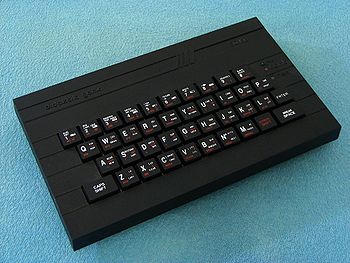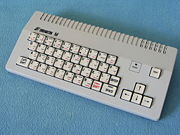
Didaktik
Encyclopedia

Home computer
Home computers were a class of microcomputers entering the market in 1977, and becoming increasingly common during the 1980s. They were marketed to consumers as affordable and accessible computers that, for the first time, were intended for the use of a single nontechnical user...
s based on the Intel 8080
Intel 8080
The Intel 8080 was the second 8-bit microprocessor designed and manufactured by Intel and was released in April 1974. It was an extended and enhanced variant of the earlier 8008 design, although without binary compatibility...
and Zilog Z80
Zilog Z80
The Zilog Z80 is an 8-bit microprocessor designed by Zilog and sold from July 1976 onwards. It was widely used both in desktop and embedded computer designs as well as for military purposes...
processors
Central processing unit
The central processing unit is the portion of a computer system that carries out the instructions of a computer program, to perform the basic arithmetical, logical, and input/output operations of the system. The CPU plays a role somewhat analogous to the brain in the computer. The term has been in...
produced in former Czechoslovakia
Czechoslovakia
Czechoslovakia or Czecho-Slovakia was a sovereign state in Central Europe which existed from October 1918, when it declared its independence from the Austro-Hungarian Empire, until 1992...
.
Didaktik Alfa
Didaktik Alfa was produced in 1986, as a "more professional" clone of PMD 85PMD 85
The PMD 85 was an 8-bit personal computer produced from 1985 by the companies Tesla Piešťany and Bratislava in the former Czechoslovakia.They were deployed en masse in schools throughout Slovakia, while the IQ 151 performed a similar role in Czech part of the country.PMD 85s were famous for their...
. It featured 2.048 MHz Intel 8080 CPU, 48 KiB
Kibibyte
The kibibyte is a multiple of the unit byte for quantities of digital information. The binary prefix kibi means 1024; therefore, 1 kibibyte is . The unit symbol for the kibibyte is KiB. The unit was established by the International Electrotechnical Commission in 1999 and has been accepted for use...
RAM, 8 KiB ROM with built-in BASIC
BASIC
BASIC is a family of general-purpose, high-level programming languages whose design philosophy emphasizes ease of use - the name is an acronym from Beginner's All-purpose Symbolic Instruction Code....
, good keyboard (compared with PMD 85), monitor video output (but not TV output) with 288×256 resolution, 4 colours. Despite some changes in ROM, it was mostly compatible with PMD 85. Didaktik Alfa 1 was a clone of PMD 85-1, Didaktik Alfa 2 of PMD 85-2.
Didaktik Beta
Didaktik Beta was a slightly improved version of previous Didaktik Alfa, having almost identical hardware.While Didaktik Alfa and Beta were mostly deployed in schools (to replace older PMD 85 computers), there was another production line, meant as home computers. These were Sinclair ZX Spectrum
ZX Spectrum
The ZX Spectrum is an 8-bit personal home computer released in the United Kingdom in 1982 by Sinclair Research Ltd...
48K clones.

Didaktik Gama
Didaktik Gama was the first clone of the ZX Spectrum with one speciality: 80 KiB RAM divided into two switched 32 KiB memory banks and 16 KiB of slower RAM containing graphical data for video output, while the size of ROM was 16 KiB. This computer had become an unreachable dream for many children and adults in former socialistCommunist state
A communist state is a state with a form of government characterized by single-party rule or dominant-party rule of a communist party and a professed allegiance to a Leninist or Marxist-Leninist communist ideology as the guiding principle of the state...
Czechoslovakia as the computer was considerably expensive and seldom available to buy. It is said there were waiting lists several years long. The design of the computer was very simple — just a grey or black box the size of A5
Paper size
Many paper size standards conventions have existed at different times and in different countries. Today there is one widespread international ISO standard and a localised standard used in North America . The paper sizes affect writing paper, stationery, cards, and some printed documents...
with flat plastic keyboard
Computer keyboard
In computing, a keyboard is a typewriter-style keyboard, which uses an arrangement of buttons or keys, to act as mechanical levers or electronic switches...
and connectors mounted on the rear side. All games developed for the ZX Spectrum 48K were generally compatible
Backward compatibility
In the context of telecommunications and computing, a device or technology is said to be backward or downward compatible if it can work with input generated by an older device...
with this computer. There is no need to say that it established massive and flourishing black market with these games country-wide as they were officially unavailable behind the "iron curtain
Iron Curtain
The concept of the Iron Curtain symbolized the ideological fighting and physical boundary dividing Europe into two separate areas from the end of World War II in 1945 until the end of the Cold War in 1989...
". An audio cassette was used as the data store and a TV
Television
Television is a telecommunication medium for transmitting and receiving moving images that can be monochrome or colored, with accompanying sound...
served as the monitor
Computer display
A monitor or display is an electronic visual display for computers. The monitor comprises the display device, circuitry, and an enclosure...
.
Didaktik Gama was produced in three variants: the first, Gama '87, fixed some bugs
Software bug
A software bug is the common term used to describe an error, flaw, mistake, failure, or fault in a computer program or system that produces an incorrect or unexpected result, or causes it to behave in unintended ways. Most bugs arise from mistakes and errors made by people in either a program's...
in the original ZX Spectrum ROM, thus breaking compatibility in some percentage of applications (read: games), and introduced its own bugs effectively inhibiting the use of the second 32 KiB memory bank from BASIC. Gama '88 fixed the original ZX Spectrum bugs in a more compatible way and fixed the memory switching bug. The last and the best model was Gama '89 which fixed some more bugs. Production of Didaktik Gama computers ceased in 1992.
Didaktik M

Aspect ratio (image)
The aspect ratio of an image is the ratio of the width of the image to its height, expressed as two numbers separated by a colon. That is, for an x:y aspect ratio, no matter how big or small the image is, if the width is divided into x units of equal length and the height is measured using this...
instead of a rectangle 4:3. In addition the whole RAM
Ram
-Animals:*Ram, an uncastrated male sheep*Ram cichlid, a species of freshwater fish endemic to Colombia and Venezuela-Military:*Battering ram*Ramming, a military tactic in which one vehicle runs into another...
was realized by one set of 64 KiB chips from which only 48 KiB were used and there was no difference between the fast and slow memory with the video content. There were two separated connectors for joystick
Joystick
A joystick is an input device consisting of a stick that pivots on a base and reports its angle or direction to the device it is controlling. Joysticks, also known as 'control columns', are the principal control in the cockpit of many civilian and military aircraft, either as a center stick or...
s and one connector for additional interfaces, such as a printer interface. Unlike the previous version of Didaktik, these connectors were typical "socialistic solution" compatible with nothing that was then available in the ČSSR
Czechoslovak Socialist Republic
The Czechoslovak Socialist Republic was the official name of Czechoslovakia from 1960 until end of 1989 , a Soviet satellite state of the Eastern Bloc....
. Thus, users were forced to develop and produce various and sometimes funny home-made interfaces to satisfy their needs. Data storing and monitor type was the same as in the case of the Gama.
Two floppy disk drives were developed and released later to offer the possibility of fast saving/loading of various programs.
5.25" floppy disk drive called D40 was introduced in 1992 and featured a "Snapshot" (see also Hibernation (computing)) button that allowed to store current content of the memory (memory image) on diskette. It was also possible later to load the memory image and continue playing the game (or whatever was stored) from the respective state.
3.5" floppy disk drive called D80 was also introduced later in 1992 at the same time as Didaktik Kompakt was released.
Didaktik Kompakt
The Didaktik Kompakt from 1992 was basically a Didaktik M with built-in floppy 3.5" 720 KiB drive and parallel printer port.These computers were famous for their simplicity allowing people with little technical ability to produce various hardware add-ons such as FDD
Floppy disk
A floppy disk is a disk storage medium composed of a disk of thin and flexible magnetic storage medium, sealed in a rectangular plastic carrier lined with fabric that removes dust particles...
controllers, AD/DA converters or software (such as Desktop — unique WYSIWYG
WYSIWYG
WYSIWYG is an acronym for What You See Is What You Get. The term is used in computing to describe a system in which content displayed onscreen during editing appears in a form closely corresponding to its appearance when printed or displayed as a finished product...
word processor
Word processor
A word processor is a computer application used for the production of any sort of printable material....
with functions like proportional text, pictures in text support, block functions, multi-font support etc.). Both version of these computers had been produced in Skalica
Skalica
Skalica is the largest city in Skalica District in western Slovakia in the Záhorie region. Located near the Czech border, Skalica has a population of 14,963 .-History:...
, Slovakia
Slovakia
The Slovak Republic is a landlocked state in Central Europe. It has a population of over five million and an area of about . Slovakia is bordered by the Czech Republic and Austria to the west, Poland to the north, Ukraine to the east and Hungary to the south...
. Didaktik's glory went out with price fall of 16-bit computers, such as the Atari
Atari
Atari is a corporate and brand name owned by several entities since its inception in 1972. It is currently owned by Atari Interactive, a wholly owned subsidiary of the French publisher Atari, SA . The original Atari, Inc. was founded in 1972 by Nolan Bushnell and Ted Dabney. It was a pioneer in...
and Amiga
Amiga
The Amiga is a family of personal computers that was sold by Commodore in the 1980s and 1990s. The first model was launched in 1985 as a high-end home computer and became popular for its graphical, audio and multi-tasking abilities...
, around the middle 90s until it was finally steam-rolled by the PC
Personal computer
A personal computer is any general-purpose computer whose size, capabilities, and original sales price make it useful for individuals, and which is intended to be operated directly by an end-user with no intervening computer operator...
soon after.
The production of Didaktik computers stopped in the year 1994.
External links
- Didaktik computers
- Didaktik computers on old-computers.com
- PCB scans
- Didaktik družstvo Skalica — the company web
- Т34ВГ1 — article about the Russian ULA

